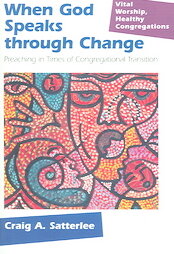Craig A. Satterlee, When God Speaks Through Change: Preaching in Times of Congregational Transition (Vital Worship, Healthy Congregations). Alban Institute, 2005.
Referenced in:
- Church Conflict – Leadership, Preaching, and Worship in Times of Conflict
- Leading Change and Transition
LifeandLeadership.com Summary
This is the third installation in a six-part Vital Worship, Healthy Congregations Series published by Alban Institute in association with the Calvin Institute for Christian Worship. While the focus of the series is worship renewal, this volume is also very insightful on the role of worship, especially preaching, in times of change, conflict, and crisis. It is in a similar genre as Kathleen Smith’s Stilling the Storm.
The book addresses a problem with literature on this subject:
“The vast majority of published perspectives and resources for preaching and worship unwittingly assume a level of constancy in congregational life, taking for granted the congregation will have the resources (emotional and otherwise) to absorb some significant new message or practice. However, on any given Sunday, a strikingly large number of churches are simply trying to cope with a significant transition in community life or leadership. These transitions do limit what preachers and worship leaders can do on Sunday, but they also present unparalleled opportunities for the reception of the gospel.” (xii)
Any preacher knows this is true. They have experienced first-hand that “a congregational transition will find its way into preaching,” that preaching “is an event involving several active participants…including the congregation, the preacher, Scripture, God, and the occasion.” (xiv)
The book is divided into two parts. The first section offers theological reflection, practical suggestions and prayerful assurance for five foundational commitments necessary for preaching in times of transition. These are:
- Understanding change. Change can be viewed either as threat or opportunity; healthy churches and their pastors will see an opportunity.
- Trusting in the power, purpose, and place of preaching in transition. Pastors must recognize that their sermons will make a difference as their congregations work through transitions.
- Welcoming the transition into sermon making. Pastors should put forth their best effort to compose sermons that “proclaim God’s grace amid change.”
- Practicing holy and active listening. To preach messages that will truly help their congregations through transition, pastors must listen to their congregations, the gospel, and the Holy Spirit, not just their own feelings.
- Staying anchored in God’s presence, grace, and power. Transitions are bound to be stressful. To lead congregations through them with grace, pastors must be grounded in the support of God and of faithful friends.
Chapter 1 includes a review of the dynamics of transition from both an organizational and theological perspective. Here he relies on the standard work of William Bridges in Managing Transitions, differentiating between change and transition, and the three phases of transition — endings, neutral zone, and new beginnings. Chapter 2 explores the benefits and risks, the power and danger of preaching in times of transition. Chapter 3 encourages preachers to welcome transition as a participant in sermon preparation. Chapter 4 addresses how the transition expresses itself through congregation, community and person of the preacher. Chapter 5 discusses how to remain rooted in the gospel and authentic spirituality while preaching through the transition.
The second section considers the type of congregational transition that results from eight specific changes or events, and how preaching may serve a resource during these times:
- Pastoral transitions
- New vision or mission
- Significant increase or decrease in worship attendance or financial giving
- Completion of a congregation’s ministry (end of a congregation’s life)
- Traumatic event in the life of the congregation, community, or nation
- Betrayal of trust (financial, sexual, etc.) within the congregation
- An event or issue that causes tension or opposition within the church or society
- The eruption of factions within the congregation
Although reflecting a more Reformed worship tradition, Satterlee’s concepts translate well into other contexts.
From the Publisher
At times, a congregational transition looms so large in a sermon that it becomes the lens through which scripture is interpreted, the congregation is addressed, the preacher is heard, and God is experienced. Homiletics professor and parish pastor Craig Satterlee reflects in this accessible, provocative volume about on how to integrate such significant events in a congregation’s life into the preaching ministry of the church. Rather than offering a blueprint for preaching, however, he walks along pastors, seminarians, and other congregational leaders who want to make sure the Gospel, not an agenda, is preached.
About the Author
Craig A. Satterlee is associate professor of homiletics at the Lutheran School of Theology at Chicago and dean of the Doctor of Ministry in Preaching Program of the Association of Chicago Theological Schools (ACTS). Dr. Satterlee served congregations in upstate New York and Michigan before being called to LSTC.
***For additional information on this resource, including reviews, click the bookstore links. Check the reference at page top or the links below for resource guides on related topics.***
Related Areas
See Other Resources on Change and Transition in Churches:
- Change and Transition in Churches, Intro
- Change Concepts and Theories
- Overcoming Change Resistance, Creating Change Receptiveness
See Other Resources on Church Conflict:
See Resource Guides on Over 100 Areas of Ministry Leadership:


